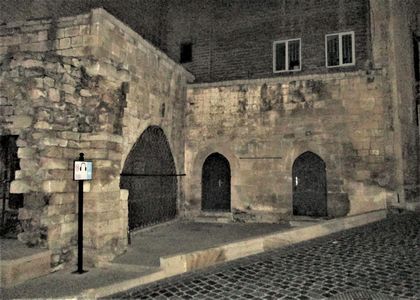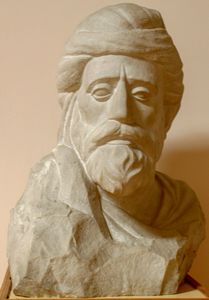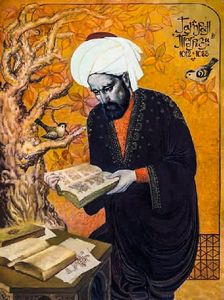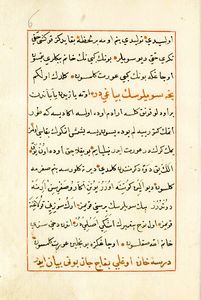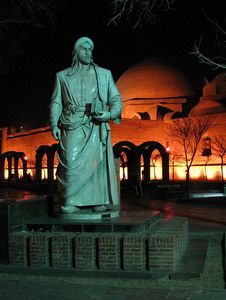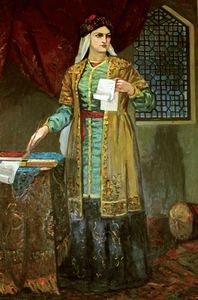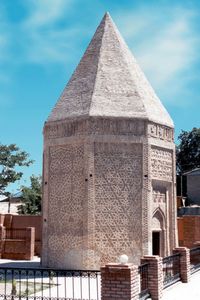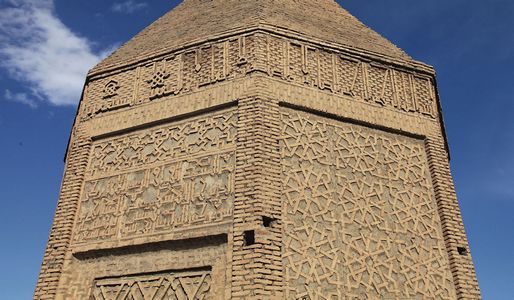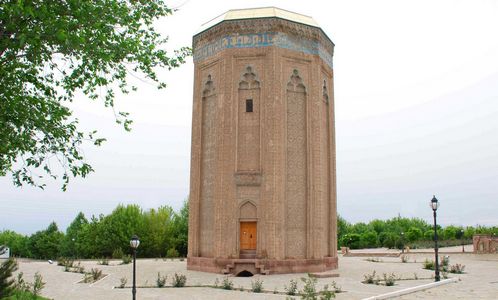Education
Liberation war of Babek Khurramite had eventually resulted in weakening of the Caliphate’s power and regaining of the independence of Azerbaijani people. Following periods of Seljuq Empire and Eldiguzids were characterized by the intensive political and economic growth of the country and the renaissance of Azerbaijani culture and science which had benefited a lot from the common Islamic culture shared by VIII-IX century Arabic, Turkic, Persian and other communities.
Rulers of the period of Azerbaijan renaissance used to pay special attention to the development of education and science. They used to gather outstanding thinkers in their courts, and open new madrasas in their respective states. Schools and madrasas of Ganja, Barda, Maragha, Shamakhi, Darband, Tabriz and Ardabil used to be popular across the entire Orient region. Primary education consisted of the classes of Quran and the introduction into different disciplines, especially logics, foreign languages and natural sciences.
One of the outstanding representatives of Azerbaijan renaissance was Khatib Tabrizi (1030-1109). Having graduated from Tabriz and Numan (Syria) madrasas, Tabrizi started giving lectures in the time’s largest education facility – “Nizamiyya” madrasa which was based in Baghdad. Tabrizi taught there for the long period of 40 years. He was known as one of the best scientists with encyclopaedic knowledge in philology and literary studies. In “Nizamiyya” madrasa, there were also other teachers from Azerbaijan, including Abu Hafs Omar ibn Osman ibn Sheyb from Ganja, Tacaddin Abul Fadail Muhammad from Urmia, Abul Fadl Mahmud from Ardabil, Kamaladdin Abu Nasr ibn Yunis from Shirvan, etc.
Science
One of the greatest scientists and poets graduated from the Nizamiyya madrasa was Omar Ganjavi – author of valuable studies in the area of philology and literary studies. Another famous scientist of the epoch was Akmaladdin Nahchivani – friend and doctor of Movlana Jalaladdin Rumi, known as “master of doctors” and “leader of world’s physicians”. Among famous physicians of Azerbaijan Renaissance there were also XII century doctor Mahmud ibn Ilyas – author of therapeutic and pharmacological encyclopaedia, and XI-XII century doctor Kafiaddin Omar ibn Osman – founder of medical madrasa and hospital in Malham (Shamakhi) in which a lot of doctors had been educated.
XII century astronomer Fazil Faridaddin Shirvani developed several valuable astronomic tables.
Great Azerbaijani philosopher Bahmanyar al-Azerbaijani thoroughly studied works of Oriental and Ancient Greek philosophers, and proposed several philosophical theories which had contributed to the development of global philosophy. Another famous XI-XII century philosopher was Eynalguzzat Miyanachi who was assassinated on the age of 32 because of his pantheistic views. In XII – beginning of XIII centuries, Mkhitar Gosh - famous representative of Albanian culture wrote his works “Ganun-name” (Book of Laws) that was based on Byzantine and Albanian laws, and “Albanian Annals”.
Literature
Just like in the other countries which became part of Arabian Caliphate, Arabic became the official language of Azerbaijan since VIII century. Arabic was also used as a language of communication between the Caliphate’s different peoples and the main language of the period’s literature and scientific works. Although the Azerbaijani poets of VII and VIII centuries used to write in Arabic, they often combined Azerbaijani and Arabic cultures in their works. For example, Arabic philologists Musa Shahavat, Ismayil ibn Yasar and Abul Abbas al-Amu, mentioned poets from Azerbaijan who wrote poems in Arabic but in traditional syllabic meter. However, Turkic folklore like proverbs, sayings and dastans had been also widely developed in Azerbaijan with its’ increasingly Turkic population. The most famous masterpiece of Turkic folklore was the “Book of Dede Korkut” – epic dastan which can be characterised as biography of all Turkic peoples. This dastan used to be very popular in the vast area between Caspian Seashore in the east, and Diyarbakir and Black Sea in the west.
Azerbaijani poets and thinkers of IX-XII centuries established Azerbaijani literary school in Tabriz, Shirvan and Ganja. In accordance with the described period’s necessities, they wrote their works in the Persian language. Although Turkic language was native for the most of the country’s people and public authorities, poems, novels and scientific works were usually written in Persian.
XI century poet Qatran Tabrizi (1012-1018) is known as the first famous palace poet of Azerbaijan. His literary heritage is represented by poems “Govsname”, “Gushname” (Book of Birds) and “Vamig and Azra”, as well as voluminous “Divan” – collection of odes. Qatran Tabrizi is the author of the first explanatory dictionary in the history of Persian lexicography. Tabrizi’s follower Abulula Ganjavi (1096-1159) had been an influential poet to the Shirvanshah court, and renowned as “malik-ash-shuara” (king of poets).
Literary school of Shirvan was then continued by Afzaladdin Khaqani Shirvani (1121-1199) - talented follower of Abudulla Ganjavi and one of the most famous poets of Azerbaijan Renaissance. Khaqani introduced new styles, grandiloquent characters and methods of verbal description into the Persian literature of Azerbaijan. His odes are among the most valuable masterpieces of the entire Oriental renaissance. Khaqani is also known as the first Azerbaijani author of a narrative poetry.
Masud ibn Namdar – Azerbaijani poet of the second half of XI – early XII centuries, wrote his poems not only in Arabic and Persian, but in his native Turkic language, too. Mujiraddin Beylagani - follower of Khaqani and talented Azerbaijani poet, used to be a poet to the courts of Mahammad Jahan Pahlavan and Qizil Arslan, and dedicated some of his odes to their majesties. Qivani Ganjavi – another XII century poet from Ganja, had praised humanitarian ideals and raised his voice against intellectual darkness, hypocrisy, unjustness and untidiness. Poet Falaki Shirvani (1126-1160) dedicated his life to the development of astrology and maths. His “Divan” is distinguished not only for its’ literary value, but also for realistic description of historical events. Another famous representative of XII century Azerbaijani poetry was the poetess Mashati Ganjavi (1089-1183) – master of rubais with deep philosophic contents.
The pearl of Azerbaijani Renaissance is, of course, Nizami Ganjavi (1141-1209) – one of the greatest figures in the entire world’s culture, who had contributed a lot to the development of both Oriental and world poetry. For centuries, greatest poets from the Near East and Middle Asian regions had been influenced by the poetical genius of Nizami, benefited from his poetic heritage and dedicated their masterpieces to the great master. Nizami had gained a worldwide fame for himself and for his nation by writing “Khamsa” - quinary of the following poems: “The Storehouse of Mysteries”, “Khosrow and Shirin”, “Leyli and Majnun”, “Seven Beauties” and “Iskander-nameh”.
Architecture
There had been several architectural schools during Azerbaijan renaissance, including Shirvan-Absheron, Nakhchivan-Maragha and Arran schools which invented specific architectural styles. Building facades of the Nakhchivan-Maragha school used to be worked with ceramics and tiles. Representatives of the Shirvan-Absheron school designed their facades based on a contrast between plain wall surfaces and plastic architectural elements. Finally, the school of Arran was distinguished for wide use of bricks.
Examples of the period’s preserved religious buildings are “Sinig gala” (Muhammad) mosque in Baku (1078/79) and Jame mosque in Ardabil. Period between IX and early XIII centuries was marked by rapid growth of the cities. During that period, Azerbaijani architects erected a lot of palaces, castles, caravanserais, bridges and mausoleums. Maiden Tower in Baku, Gulustan Tower in Shamakhi, Bughurd castle on Aghsuchay, Alinja castle in Nakhchivan, Oghlan gala in Lerik, Castle of Absheron and other similar buildings are among rare examples of the world’s architecture. Maiden Tower in Baku is one of the greatest monuments ever erected on the territory of Absheron peninsula. This uniquely designed and 28 m high tower had been constructed by Masud Davudoghlu atop a large cliff on the Caspian shore. Special mention in the regard of the period’s fortifications shall be made of the Quadrangular castle built in Mardakan in (XIV century), and the Round tower erected in the same settlement in (1232).
The most prominent architect of Azerbaijan Renaissance is Ajami ibn Abubakr who had lived in XII century, established architectural school of Nakhchivan and gained a title of the “sheikh of engineers”. Ajami enriched architectural traditions of the past and designed magnificent architectural complexes by proceeding from complicated mathematical calculations. The architect’s greatest masterpieces include mausoleums of Yusif ibn Kuseyir and Momine Khatun, both worked with decorative limestone and decorated with complex geometrical ornaments and Kufic-style plaques.
One of the greatest architectural monuments of Azerbaijan Renaissance is famous Khodaafarin Bridge erected in 1027 across the riverbed of Araz by the Shaddadid ruler Fazl ibn Muhammad. For centuries, this 15-arch structure connected southern and northern parts of the country, playing important role in the maintenance of military and political communications.
Applied arts
Artisans of Azerbaijan Renaissance used to be very skilful in metalworking crafts. Prepared from metal and covered with unique ornaments, crockery and arm artefacts of the period are very valuable as art masterpieces. One of the most illustrative examples is the city gate of Ganja. Manufactured in 1063 by Ibrahim Osmanoghlu at the direction of Shaddadid ruler Abulasvar Shavur, these gates had been damaged during disastrous Ganja earthquake of 1139 and later taken as trophy by Georgian invaders.
Pottery (ceramics) had been the most widespread type of Azerbaijani applied arts of XI – early XIII centuries. Major pottery centers of the country were based in Beylagan, Shamakhi, Ganja, Nakhchivan and Tabriz.
Other developed types of the applied arts were carpet-weaving and embroidery.
